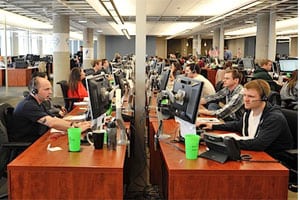
The ability to buy its way into the full truckload (FTL) brokerage sector, while gaining significant capabilities in freight backhaul services – filling in excess capacity on return truck trips – are what led UPS to its $1.8 billion acquisition of trucking brokerage services provider Coyote Logistics, a company executive said.
“The FTL market is huge, and a great opportunity for us,” said Alan Gershenhorn, chief commercial officer for UPS. “And the brokerage sector is highly fragmented, with Coyote one of the market leaders out there, certainly one of the more innovative ones.”
In a March report, the American Trucking Association estimated the overall U.S. FTL market, including asset-based companies, brokers, dedicated fleets and private fleets, at $700 billion, with the brokerage component alone estimated at $56 billion.
Gershenhorn said Coyote – which UPS has already been using – provides highly complementary assets by helping the carrier fill in 7 million empty trip legs a year, as it taps its massive network of 35,000 trucking companies. He added that Coyote is strong in food, beverage and consumer goods verticals, areas where UPS doesn’t have as much of a footprint as it does in manufacturing, wholesale and retail.
“Our mission is to create a solution that is greater than the sum of its parts for our customers, between backhaul capacity, new business and cross-selling opportunities,” Gershenhorn said. “Their culture, value, expertise and innovation fit well with UPS.”
On its most recent analyst call, Gershenhorn talked about UPS’s efforts to flatten out the U-shaped nature of demand during the peak holiday season – higher at both ends, lower in the middle – and the impact on its network capacity. He said the Coyote acquisition will at least help address the heaviest periods.
“Because of that that demand, it’s when we have the greatest need for purchased transportation, and certainly Coyote has already been working with us since 2012 to help us address the peakiness of the season,” he said. “The ability to have them providing added assets needed for those two ends of that U are very powerful.”
Beyond that, Gershenhorn said UPS is working to align its operations more closely with the plans and projections of major retail customers in an effort to spread out peak demand more evenly. For instance, he said, most of the additional ecommerce orders from Black Friday through Cyber Monday are for Christmas presents and self-gifting.
“So the time in transit needs for those packages is not necessarily immediate,” he said. “Retailers are facing the same challenges as all of us do, staffing up to fulfill and push those orders out. If we can find a way to process them on a more scheduled basis as orders come in, that helps with peakiness. We’re working in concert with them as they try to understand the true needs of consumers, and what their expectations are in terms of when packages arrive.”
